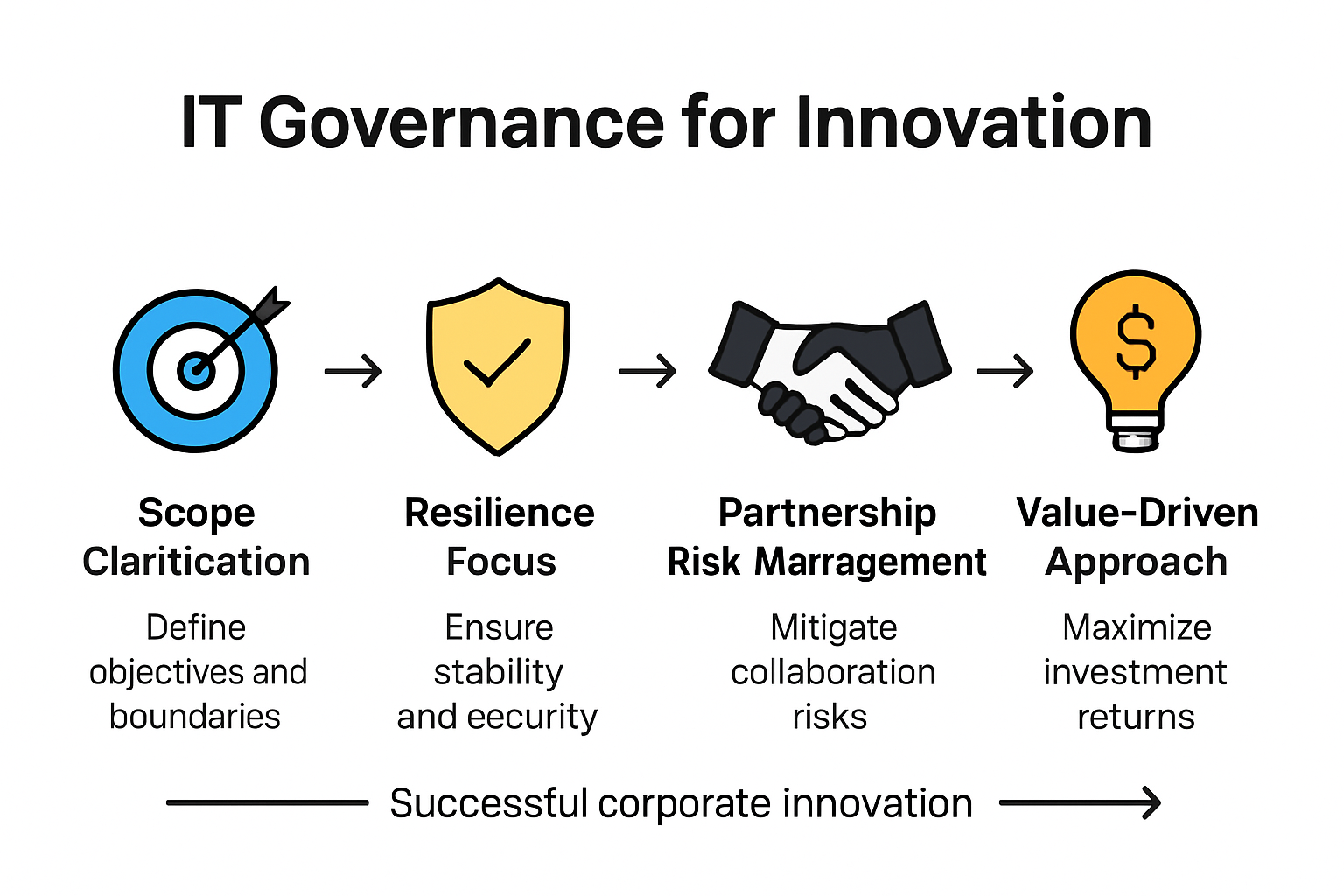


Corporate Innovation Programs: Structures, Benefits, and Best Practices
Every company wants the next big breakthrough, but building real innovation is not as simple as hiring a creative team or trying out new tech. Even though nearly 80 percent of executives rate innovation as a top-three priority, most corporate innovation programs struggle to deliver lasting results. Surprise comes when you realize that the secret to success is not about wild ideas or huge budgets. The real edge comes from the structures, culture shifts, and measurement systems almost nobody talks about.
Table of Contents
- Understanding Corporate Innovation Programs
- Key Types And Models Explained
- Critical Success Factors And Challenges
- Measuring Impact And Return On Innovation
Quick Summary
| Takeaway | Explanation |
|---|---|
| Empower decentralized decision-making | Encourage teams at all levels to evaluate and propose innovative ideas for better engagement and creativity. |
| Foster a culture of continuous learning | Build an environment where employees feel safe to experiment and learn from failures, driving innovation. |
| Utilize comprehensive metrics | Implement holistic assessment frameworks that capture financial, strategic, and ecosystem impacts of innovation efforts. |
| Integrate open innovation practices | Collaborate with external partners to leverage diverse knowledge sources, enhancing adaptability and creative potential. |
| Develop adaptive risk management frameworks | Create flexible strategies that can quickly respond to disruptions and foster a balance between innovation and stability. |
Understanding Corporate Innovation Programs
Corporate innovation programs represent strategic frameworks designed to systematically generate, nurture, and implement groundbreaking ideas within organizational environments. These programs transcend traditional research and development approaches by creating structured pathways for transformative thinking and technological advancement.
The Core Architecture of Innovation Ecosystems
At their fundamental level, corporate innovation programs are complex interconnected systems that bridge internal capabilities with external opportunities. Explore our comprehensive innovation management guide to understand how organizations design these intricate ecosystems. According to research from the National Academies Press, successful innovation programs typically feature several key structural components:
- Decentralized Decision Making: Empowering teams across different organizational levels to contribute and evaluate innovative concepts
- Cross-Functional Collaboration: Creating channels for knowledge exchange between departments, disciplines, and expertise domains
- Flexible Resource Allocation: Developing adaptive funding mechanisms that can quickly support promising initiatives
These programs recognize that innovation cannot be confined to traditional silos or hierarchical structures. Modern corporations understand that breakthrough ideas can emerge from unexpected sources, requiring organizational architectures that are fundamentally more fluid and responsive.
Strategic Objectives and Transformation Mechanisms
Corporate innovation programs serve multiple strategic objectives beyond mere product development. They function as organizational transformation mechanisms that address critical business challenges. As organizational research from leading academic institutions demonstrates, these programs aim to:
- Cultivate an internal culture that values continuous learning and experimentation
- Generate sustainable competitive advantages through systematic innovation
- Identify and mitigate potential market disruptions before they impact core business models
The most effective corporate innovation programs are not passive recipients of ideas but active orchestrators of creativity. They establish clear evaluation frameworks, provide necessary resources, and create psychological safety for employees to propose unconventional solutions. By implementing structured yet flexible innovation management processes, organizations can systematically convert intellectual potential into tangible business value.
Understanding corporate innovation programs requires recognizing them as living, dynamic systems that require continuous nurturing, strategic alignment, and a commitment to fostering a culture of creative problem-solving. These programs represent more than mere initiatives—they are fundamental redesigns of how organizations approach growth, adaptation, and sustained competitive relevance in an increasingly complex global marketplace.
Key Types and Models Explained
Corporate innovation programs encompass diverse models and approaches that organizations strategically deploy to drive technological advancement and competitive differentiation. Explore our comprehensive innovation insights to understand the nuanced landscape of innovation strategies.
Centralized versus Decentralized Innovation Models
Innovation models can be fundamentally categorized into centralized and decentralized frameworks, each with distinct characteristics and operational dynamics. According to research from the Product Development and Management Association, organizations like Amazon have pioneered decentralized approaches such as the ‘two-pizza team’ model. These small, autonomous teams are designed to enhance operational flexibility and accelerate innovation cycles.
- Centralized Innovation: Concentrated decision-making within dedicated innovation departments or specialized teams
- Decentralized Innovation: Distributed creativity across multiple organizational units, encouraging bottom-up idea generation
- Hybrid Approaches: Combining centralized strategic oversight with decentralized execution capabilities
Centralized models provide structured governance and aligned strategic direction, while decentralized models offer agility and diverse perspectives. The most effective corporate innovation programs often integrate elements from both approaches to create robust, adaptable innovation ecosystems.
To clarify the distinctions between centralized, decentralized, and hybrid corporate innovation models, the following table summarizes their key characteristics based on the article’s descriptions.
| Model Type | Key Characteristics | Example/Emphasis |
|---|---|---|
| Centralized Innovation | Decision-making & resources concentrated in dedicated teams or departments | Structured governance, alignment |
| Decentralized Innovation | Distributed creativity across units; bottom-up idea generation | Flexibility, diversity, agility |
| Hybrid Approach | Mix of centralized oversight and decentralized execution | Balance of control and innovation |
Open Innovation and Collaborative Frameworks
Modern corporate innovation programs increasingly embrace open innovation models that extend beyond traditional organizational boundaries. Open innovation research demonstrates the power of leveraging external knowledge sources, including customers, academic institutions, and even potential competitors.
Key characteristics of open innovation models include:
- External Knowledge Integration: Actively seeking and incorporating ideas from outside the organization
- Collaborative Platforms: Creating structured mechanisms for external stakeholder engagement
- Bidirectional Knowledge Flows: Enabling both inbound and outbound knowledge transfer
These collaborative frameworks recognize that breakthrough innovations are not exclusively generated internally but can emerge through strategic partnerships, crowdsourcing, and cross-sector collaborations. Companies implementing open innovation models demonstrate greater adaptability and faster response to emerging market trends.
Technology-Driven Innovation Archetypes
Technology-driven innovation models represent sophisticated approaches that leverage emerging digital technologies to transform traditional innovation processes. These models are characterized by their emphasis on technological capabilities, data-driven insights, and rapid prototyping.
Primary technology-driven innovation archetypes include:
-
Digital Innovation Labs: Dedicated units focused on exploring emerging technologies
-
Corporate Venture Capital: Direct investment in promising external startups and technological innovations
-
Digital Ecosystem Platforms: Creating interconnected networks that facilitate continuous innovation and technological exchange
Successful technology-driven innovation models integrate advanced digital tools, machine learning algorithms, and experimental technologies to generate novel solutions and maintain competitive advantages. By embracing these sophisticated approaches, organizations can transform potential technological disruptions into strategic opportunities for growth and differentiation.
Critical Success Factors and Challenges
Corporate innovation programs require sophisticated strategies and nuanced approaches to overcome inherent organizational barriers and maximize potential transformative outcomes. Learn about innovative approaches to overcome challenges to understand the complex dynamics of successful innovation implementation.
Organizational Alignment and Governance
Successful corporate innovation programs demand robust governance frameworks that systematically address complex organizational challenges. According to ISACA research, five critical IT governance constructs are essential for effective innovation management:
- Scope Clarification: Defining precise boundaries and depth of innovation initiatives
- Resilience Focus: Ensuring sustainable and adaptive innovation strategies
- Partnership Risk Management: Understanding potential collaboration implications
- Value-Driven Approach: Allocating appropriate financial resources
- Strategic Technology Integration: Aligning new technologies with organizational objectives
These governance mechanisms help organizations create structured pathways that transform innovative potential into tangible strategic advantages. By establishing clear guidelines and evaluation metrics, companies can systematically mitigate risks associated with innovation implementation.
The article outlines several governance components critical to successful innovation programs. This summary table organizes these elements for easy reference.
| Governance Component | Description |
|---|---|
| Scope Clarification | Defines boundaries and depth of initiatives |
| Resilience Focus | Ensures sustainability and adaptability |
| Partnership Risk Management | Assesses collaboration implications |
| Value-Driven Approach | Allocates financial resources strategically |
| Strategic Technology Integration | Aligns technology adoption with organizational objectives |

Employee Engagement and Cultural Transformation
Employee involvement represents a fundamental critical success factor in innovation program development. Research from the National Institutes of Health emphasizes that knowledge management implementation heavily depends on creating participatory environments. Particularly in smaller organizations, where knowledge is often concentrated among key leaders, developing inclusive innovation cultures becomes paramount.
Key strategies for fostering employee engagement include:
- Participatory Design: Creating collaborative platforms that encourage idea sharing
- Shared Vision Development: Establishing collective innovation narratives
- Knowledge Sharing Mechanisms: Implementing structured communication channels
- Cultural Transformation: Normalizing continuous learning and experimentation
Successful innovation programs recognize that technological solutions alone cannot drive meaningful change. They require comprehensive cultural transformations that empower employees at all organizational levels to contribute meaningfully.
Risk Management and Strategic Adaptation
Navigating the complex landscape of corporate innovation necessitates sophisticated risk management approaches. Organizations must develop flexible frameworks that can rapidly respond to technological disruptions and market shifts. This requires creating adaptive ecosystems capable of balancing innovative exploration with strategic stability.
Critical risk management considerations include:
- Continuous Learning: Developing mechanisms for rapid knowledge acquisition
- Experimental Mindset: Encouraging calculated risk-taking
- Failure Tolerance: Creating psychologically safe environments for innovation
- Iterative Evaluation: Implementing robust feedback and assessment processes
Ultimately, successful corporate innovation programs transcend traditional linear approaches. They represent dynamic, interconnected systems that require constant refinement, strategic alignment, and a commitment to transformative thinking. By embracing complexity and developing holistic innovation strategies, organizations can convert potential challenges into significant competitive advantages.
Measuring Impact and Return on Innovation
Measuring the impact and return on innovation represents a complex challenge for organizations seeking to quantify the strategic value of their innovation initiatives. Discover comprehensive strategies for innovation measurement to transform abstract innovation efforts into tangible organizational insights.
Comprehensive Metrics and Evaluation Frameworks
Traditional measurement approaches often fall short in capturing the multidimensional nature of corporate innovation. According to the OECD’s innovative measurement perspective, organizations must develop holistic evaluation frameworks that extend beyond conventional R&D metrics.
Key comprehensive measurement dimensions include:
- Innovation Input Metrics: Resources allocated to innovation initiatives
- Process Performance Indicators: Efficiency of innovation development cycles
- Outcome Transformation Metrics: Tangible business value generated
- Ecosystem Impact Assessment: Broader organizational and market transformations
These multifaceted metrics enable organizations to develop nuanced understandings of their innovation performance, moving beyond simplistic financial calculations to capture the true strategic potential of innovative endeavors.
Financial and Strategic Value Assessment
The National Institute of Standards and Technology’s research highlights the critical importance of translating innovation investments into measurable economic value. Strategic value assessment requires sophisticated approaches that integrate financial performance with long-term organizational capabilities.
Critical value measurement strategies include:
- Direct Economic Returns: Quantifying revenue generated from new products or services
- Competitive Positioning: Assessing market share and differentiation gains
- Capability Enhancement: Measuring organizational learning and adaptive capacity
- Intellectual Asset Valuation: Tracking patent generation and knowledge asset development
Successful organizations recognize that innovation return extends beyond immediate financial metrics, encompassing strategic capabilities that position them for future market opportunities.
Technological and Sustainability Impact Analysis
Emerging research demonstrates the interconnection between technological investment, sustainability, and innovation performance. A comprehensive study from the Association for Information Systems reveals the complex relationships between corporate sustainability initiatives and innovation outcomes.
Advanced impact analysis frameworks should consider:
- Technology Readiness Levels: Assessing technological maturity and potential
- Sustainability Innovation Metrics: Measuring environmental and social impact
- Long-Term Transformational Potential: Evaluating innovation’s strategic significance
- Ecosystem Resilience Indicators: Understanding broader innovation ecosystem dynamics
By adopting sophisticated, holistic measurement approaches, organizations can transform innovation from a nebulous concept into a strategically managed organizational capability. The most successful innovation programs view measurement not as a retrospective exercise but as a dynamic, forward-looking process of continuous learning and strategic refinement.

Frequently Asked Questions
What are corporate innovation programs?
Corporate innovation programs are strategic frameworks designed to systematically generate, nurture, and implement groundbreaking ideas within organizations, going beyond traditional R&D by creating structured pathways for transformation.
What are the key structures involved in corporate innovation ecosystems?
Successful corporate innovation ecosystems typically include decentralized decision-making, cross-functional collaboration, and flexible resource allocation to enable fluid and responsive organizational architectures.
How can organizations measure the impact of their innovation initiatives?
Organizations can measure the impact of their innovation efforts through comprehensive metrics that include innovation input metrics, process performance indicators, outcome transformation metrics, and ecosystem impact assessments to gain a multidimensional understanding of their performance.
What role does employee engagement play in the success of innovation programs?
Employee engagement is crucial for innovation program success, as it fosters participatory environments, encourages idea sharing, and promotes a cultural transformation that normalizes continuous learning and experimentation.
Ready to Transform Your Corporate Innovation Program into Real Business Outcomes?
Too many organizations find themselves stuck at the idea stage. The article reveals how lacking the right structure or engagement strategy can lead to missed opportunities, wasted resources, and a culture where real innovation barely moves forward. If these challenges sound familiar, you deserve proven solutions that help you empower teams, break down silos, and deliver results that leadership notices.

Skipso gives you the platform to turn best practices into action. From running high-impact innovation challenges to building agile innovation ecosystems, our software supports every step described in this article.
- Discover how you can upgrade your entire innovation lifecycle by visiting Skipso’s innovation management solutions.
- Take the first step to organizational change. Request a demo on our homepage and see how your teams can move from ideas to impactful outcomes today.
Recommended













